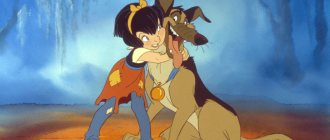Cartoons about dogs are one of the significant elements of a child’s socialization, along with other animated films about animals and fairy tale therapy, which influence the development and formation of the child’s value orientation. Foreign animated films predominantly focus on the behavioral characteristics of the characters, while domestic ones focus the child’s attention to a greater extent on the characterological traits of the characters. Hollywood cartoons about dogs attract attention with the colorfulness, brightness and dynamism of the plot; cartoons produced in the USSR and the Russian Federation attract attention with the relationships between the characters and the moral message of the storyline. This publication contains selected animated films of domestic and foreign production, which are rightfully considered the best in this thematic category.
Fusion of filigree animation
“101 Dalmatians” (1961) is one of the best films from Walt Disney Studios. This is a unique fusion of bright characters, precise animation, sparkling humor and an extraordinary plot structure. The plot of the cartoon is quite funny. The Dalmatian dog Pongo decides to unite the hearts of his owner Roger and one worthy young lady Anita, who also has a pet Dalmatian. The human heroes and their four-legged friends fell in love with each other, and soon a pair of Dalmatians had beautiful puppies. They immediately became the object of desire for a greedy and cruel woman, Cruella De Vil, who dreamed of acquiring a fur coat made from the wool of babies.
The rise of Czech animation
Czech film animation was founded by the famous master Jiri Trnka. The name of this puppet animator is associated with the flourishing of the entire direction, designed for the attention and understanding of children. Karel Zeman was the first to successfully use special effects in cinema, combining animation and drama. The ground was created for the emergence of exciting and useful animated films for children. She made it possible to talk about important things in a form accessible to the children, such as the friendship of Stepladder and Macaronina, which helped them cope with all misfortunes and fight back against hidden deceit and cunning.
The most famous fairy tale that glorified Czech cinema was “The Proud Princess,” which was filmed back in the fifties of the twentieth century and was liked by all young viewers. Works for young viewers that are striking in their cheerful love of life and sparkling humor were created by Vaclav Bedřich, a director, animator and teacher beloved by children, and the author of widely known children's animated series.
Characters
The presence of a character like Cruella made the cartoon's narrative quite tense. The antagonist, who, after the release of the cartoon, occupied the top lines of the tabloid of the most terrible Disney villains, is a real flayer, ready to do anything to achieve her goal. This is a fairly bright character, with an eloquent name, a decent emotional range and grotesque facial expressions. Secondary characters are responsible for the humorous component of the picture: textbook thieves-blunderers Horace and Jasper and Sergeant Tibs. The necessary atmosphere of the cartoon is also achieved through impeccably drawn locations: London shrouded in mystery, the rural district conducive to serenity, Cruella’s macabre mansion. “101 Dalmatians” is a beautiful, truly kind and elegant animated film worthy of admiration.
From the biography of the creator of an instructive comedy
Bedřich was born in 1918. Due to the outbreak of the Second World War in Europe, he was unable to receive a special education. For many years he worked at the film studio Atelier of Animated Films. He soon became one of the main animators here and even then attracted the attention of young viewers to his works.
Czech animator Václav Bedřich is the creator of Stepladders and Macaroni.
The war ended, the artist moved to study and work in the studio of the already famous animator Jiri Trnka. Bedrich collaborated with him for many years and delighted the guys with memorable cartoons.
In the sixties of the last century, the artist and teacher became the founder of evening television programs intended for children of primary school age and preschoolers. Under his leadership, the talent of such famous animators and artists as Ciril Bouda, Adolf Born, Miroslav Stepanek was formed, who did a lot for the development of animation and attracting children to entertaining and educational programs.
The wonderful director died in Prague in 2009.
A story of true friendship
The Fox and the Hound (1981) is an animated film adaptation of the work by Daniel P. Mannix. A dramatic story of growing up, friendship and devotion between Copper the puppy and Todd the fox. The story is based on a dramatic story of affection and friendship, revenge and loyalty, and the internal struggle with the own “I” of each of the main characters. The story of making fateful decisions, decisive actions and subsequent responsibility for them. This heartfelt, powerful and vibrant work of animation is undoubtedly one of the best in the Dog Cartoons category. The cartoon is bright, memorable for all its components: from high-quality, highly artistic depiction, sympathetic characters, a general dramatic atmosphere to an impressive emotional climax.
How it all began
It all started early in the morning. An ordinary dog kennel, it’s quiet. Suddenly there is a sharp knock on the door. But there is still silence there, no one is in a hurry to relieve the constipation. All you can hear is the light snoring of two bosom buddies, Stepladder and Macaroni. The dogs carried out a difficult service all night long, they were on duty, and now, tired, they fell asleep in a righteous sleep.
And this is the robber crow - she constantly harms our dogs.
But the crow has no one to play with, she, the gray robber, is bored, that’s why she strives to dissuade her neighbors from sleeping. Moreover, she is obsessive and proud by nature, she wants everything to be the way she needs it.
The insidious bird takes unfriendly actions against its neighbors. And those - be on the alert, they are also not born with bast. In general, Stremyanka and Macaronina give a worthy rebuff.
Well, the gray robber managed to dismantle part of the neighbor’s house and play a dirty trick on the dogs. Friendship and hard work are stronger than the crow's cunning. You can see this for yourself by watching all thirteen episodes on our website for free.
The children's series was filmed in Czechoslovakia with family viewing in mind. The years of release are considered to be 1969-1971, as well as 1989. The animated film appeared on cinema screens on January 1, 1988. During the school holidays, a lot of kids immediately learned a lot of interesting things about the lives of two wonderful dogs. They saw how an impudent crow tried to disrupt life in a well-maintained kennel. Not only did she deprive her friends of a roof over their heads, but she also began to prevent them from building a house. You can watch how she did this in Vaclav Bedřich’s comedy online. Well, adventures befell the inseparable dogs!
Let's take a breath and remember some more immortal heroes of Czech animation - the kind forest people and their naive adventures. Think for a moment, do your children know about them? Or are they more interested in hanging out on VKontakte and playing stupid games? Be smart parents - tell them that on VKontakte you can watch a cartoon about Krzemelik and Vakhmurka online.
Four-legged superhero
"Volt" is a cartoon with a fairly simple plot. The charming dog Volt has been living in the world of TV shows since childhood; he believes in the reality of what is happening around him, not suspecting that all these are special effects. His confidence dissipates when the dog, rushing to the rescue of his mistress, whom he thought had been kidnapped, finds himself in the real world - beyond the boundaries of the television studio. This is where his real adventures begin; a charismatic hamster will accompany the hero through the wilds of reality. As a result, the dog will not only adapt to the world of ordinary people, but will also prove his worth to everyone. Without spoilers, this is the plot of the film “Volt”. The cartoon was created with very high quality, the animation and graphics are almost flawless. At the same time, the chases, explosions, and other special effects that generously fill the plot narrative are striking in their scope, and the 3D effect enhances the viewing experience significantly.
Polish cartoons in the USSR
Perhaps the oldest Polish series, which was also broadcast in Soviet children's programs, were stories about two playful boys - Lelek and Bolek (the prototype for these characters were very real children - the sons of the director of an animation studio). The series was born back in 1962 and was broadcast all over the world, including the Soviet Union. A little later, based on this famous cartoon, the production of chewing gum of the same name with colorful inserts was launched.
A little later, in 1967, another wonderful animated series about a dog named Rex (Resio) was released. This funny and good-natured dog, who always finds wise and fair solutions for some difficult life situations, was loved not only by children, but also by adults: parents also watched cartoons about Rex’s adventures with great pleasure.
Another Polish series, which, unfortunately, was not shown in the USSR as often as children would like, was about Mishka Ushastik (not to be confused with the domestic series about a bunny with the same name). In Poland, this good-natured bear cub with a curved ear was a real television star, and he enjoyed no less success in those 22 countries. who acquired the rights to show the series - in Finland, for example, from an exhibition dedicated to the cartoon, once they even stole the dolls-heroes of the series - so much did Mishka and his friends fall in love with the audience.
In 1964, another cartoon was released on Polish screens, which was expected to be extremely popular in the USSR - “The Magic Pencil ”. There are no dialogues in the cartoon, but they are not needed - the main character, the boy Petrek, finds himself in various situations, from which he finds a way out with the help of an unusual pencil: everything you draw with this pencil comes to life. Needless to say, how vigorously Soviet children discussed this cartoon after watching it, dreaming about what kind of things they could materialize for themselves with the help of such a pencil...
The animated series, in which the main character is a girl, stands out somewhat from the general series of stories about mischievous boys and animals. True, the main character of the cartoon “ About Dorotka ” is also not the most obedient girl in the world, but she has a kind heart and responsiveness. The series consists of 10 issues and, as in all other cases, does not require dialogue.
Another infrequent guest on Soviet television screens is the animated series “ The Strange Adventures of the Goat Matolek .” The cartoon was created based on one of the most popular children's books and, using beautiful graphics, told about the adventures of the traveling goat Matolek.
Today, for some reason, few people remember this series, although in the late 60s and early 70s it was shown quite often in the program “Good night, kids!” We are talking about the cartoon “ Charming Clock Resident ,” which tells about a gnome who lives in an old clock and often comes to the rescue of the inhabitants of the apartment.
Cartoons from the USSR era
Soviet animation is famous for its masterpieces: they are not only necessarily instructive, but also infinitely kind, funny and colorful. Unlike foreign animation, very few films were produced in the USSR that would be equally interesting to both children and adults. But there are individual copies that are still in demand, popular and exist outside the format of a certain age audience. The clearest example is the cartoon “Once Upon a Time There Was a Dog.”
“I’ll sing right now!”
The talented cartoon director and screenwriter Eduard Nazarov, who later directed the super-popular modern animated series “Masha and the Bear,” created an animated short film based on the Ukrainian folk tale “Sirko.” According to the story, once upon a time there lived a Dog. He faithfully served his masters until he grew old and was expelled from the court. The unfortunate character went into the forest to settle scores with his worthless life. But the intervention of the Wolf, as old and unhappy as the Dog, made significant adjustments to his plans. From this moment - a fateful meeting, a well-filmed and gorgeously voiced life and sad story begins. By the way, the Wolf over time acquired a symbolic meaning for the Slavic mentality and soul, and became a national symbol of Soviet animation. His steel sculpture weighing about two tons was created according to the sketches of Mikhail Ivashko and installed in Angarsk (Irkutsk region). When listing cartoons about dogs from the USSR era, it is impossible not to mention this unique work of animation art.
"Man is a dog's friend"
“Bobik visiting Barbos” (1977) is another outstanding Soviet comedy animated film, the work of animator director Vladimir Popov and the creative union of playwrights and screenwriters Mikhail Libin and Nikolai Nosov. For the adult generation of viewers, this cartoon has a touching nostalgic meaning. It is very unpretentious and even simple, but everything ingenious is simple. The plot tells about two prankish dogs Bobik and Barbosa, who, taking advantage of the absence of their owner, throw a real party with dancing on jelly. It’s hard to imagine what kind of devastation and chaos will be left in place of this nice cozy house. This informative, funny and laconic cartoon teaches the little viewer the skills of behavior not only in society, but also alone with himself. Behind the seemingly simple and simple plot lies a powerful, instructive moral message. It’s worth remembering the soundtrack of the cartoon “Bobik Visiting Barbos” - the humane, cheerful song “Man is a Dog’s Friend.”
The Adventures of Stepladder and Macaroni
Czech animation began to develop thanks to the works of the well-known Jiri Trynka, a puppet animator, and Karel Zeman, who for the first time managed to use cinematic special effects, combining drama and animation. Thanks to them, the ground was formed for the creation of a famous cartoon that told young viewers about such an important thing as true friendship.
The Czechoslovakian cartoon about Stepladder and Macaroni was filmed and directed by Václav Bedřich (Warclav Berdzhich), thanks to the interesting script of Alena Munkova. The animation artist for the series was Zdenek Smetana. Jaroslav Celba (Jaroslav Tselba) gave the film extraordinary dynamics, writing perky musical compositions for the cartoon.
The original name is “Staflik a Spagetka”. Soviet children recognized it under the title “The Adventures of Stepladder and Macaronina.” The cartoon is very funny and dynamic, with many funny moments. It was filmed exclusively in Czech traditions.
“Staflik a Spagetka” - two inseparable dogs, a black dachshund - Macaroni and a white shaggy mongrel - Stremyanka. The third main character is the insidious Crow, a negative character.
The animated series was released from 1969 to 1971 and in 1989. Designed for children and family viewing. It was first released in theaters on January 1, 1988.
The animated series is full of colorful adventures and funny stories. There are 26 episodes in the animated series. Each episode is a completely new eight-minute story with a fully developed plot, which has an original beginning and a logical conclusion.
The plot of each episode is approximately the same. Two friends live peacefully and calmly until a neighbor, Crow, appears and tries in every possible way to harm them. For example, Stremyanka and Makaronina are watching TV peacefully without bothering anyone, but the villainous crow is already rushing towards them with another insidious plan, after which the “war” begins.
In addition to the showdown with the harmful neighbor, the friends still have a lot to do: they need to build a destroyed black house, make repairs in it, and furnish the new home with suitable furniture. In addition, you need to plant a garden and cook food. Friends don’t forget about their leisure time: they go to the beach, fish, play chess, play sports, and read.
The cartoon shows a vivid example of hard work, true friendship and the power of good over evil. The interesting and, most importantly, educational story of Stepladder and Macaronina is still popular today among children of different ages.
"The Royal Mongrel"
“Smart Dog Sonya” is a hand-drawn cartoon from the Ekran film studio, filmed in 1991 based on the book by Andrei Usachev, and consists of two issues. According to the general idea that unites both episodes, a very intelligent dog named Sonya lives in an apartment building with the owner Ivan Ivanovich Korolev, whose surname is due to her nickname “royal mongrel”. Despite the fact that Sonechka is a very well-mannered and polite dog, she manages to get into amazing and incredible stories with enviable frequency. She comes out of every situation with dignity, always drawing conclusions for the future. In each episode, everything was chosen by the authors just perfectly, from the voice acting of the characters and the timbre of the narrator’s voice to the small nuances of the visual part.
The project was conceived by the creators as a children's educational mini-series, but only two episodes were released. This is due to a difficult period in the life of the country; in the 90s, no one had time for didactic mini-series for kids. The first episode consists of miniatures: “Who Made the Puddle?”, “Hello, Thank You and Goodbye,” “Mustard.” The second is represented by short animated sketches: “Stain” and “Which is better?”





